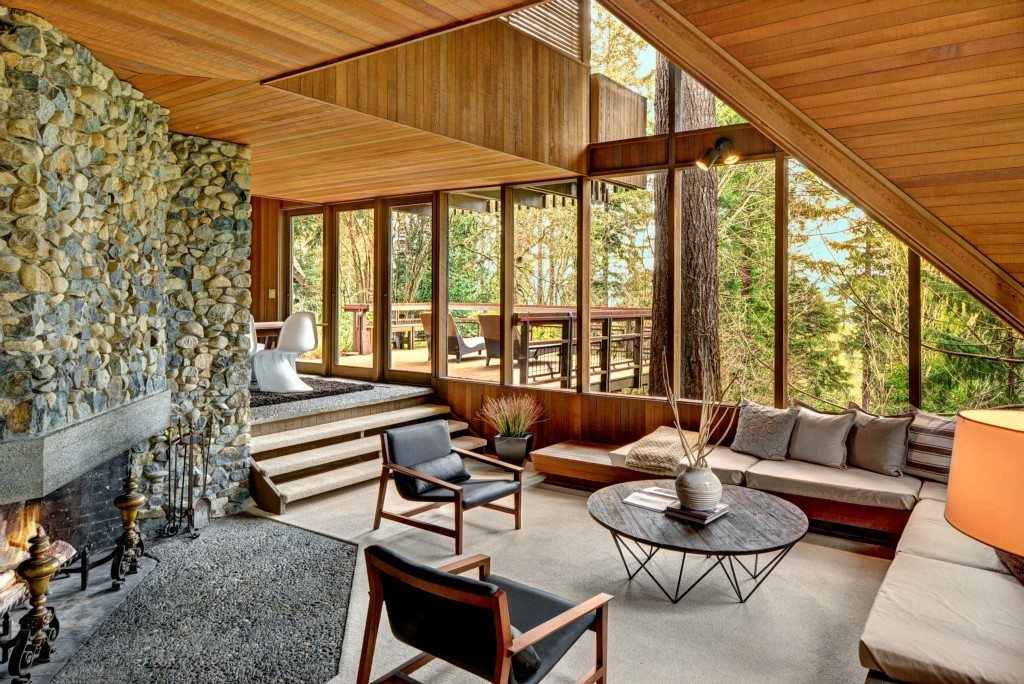A large extent of the modern architecture being built in the Pacific Northwest today is influenced by the regional style that was emerging during the Post-World War II era around the Northwest. Many of the famed architects associated with this movement had design philosophies that were deeply rooted in the teachings of the Bauhaus movement, which was ‘one of the most influential currents in modern design, Modernist architecture and art, design and architectural education’ in the early part of the twentieth century (Wikipedia.org). Japanese aesthetics also influenced the Northwest regional style, primarily due to the similarities in climates between the Northwest and Japan, and the post and beam construction techniques that were essential to build on the rugged and often steep terrain of both landscapes. Pioneering architects and builders around the region made use of the local natural resources available to them, thus laying the groundwork for some of today’s current sustainability standards. It is these defining characteristics that set the tone for creating an architectural style that is distinctively Northwest.
Northwest Regionalism is this uniquely local interpretation of mid-century modernism that is not found anywhere else…embodies the essence of our region. (ctabuilds.com)
Some of the most notable names to be associated with the Northwest Regional Movement include Seattle based architects like Paul Thiry and Paul Hayden Kirk who were both graduates of the influential Architecture program at the University of Washington. In Portland, John Yeon, and Italian born architect Pietro Belluschi, with his background in the International Style, were making waves in creating trailblazing regional architecture for the Northwest as well.
 Source: Zillow
Source: Zillow
Architects of the NW regional style gave special consideration to the moderate climate of the Pacific Northwest to shape the relationship of structures to their surroundings. The overcast skies, and damp terrain associated with the region contributes strongly to the need to make intentional design choices that best suit the environment of the building being constructed. Major features of this style include large expanses of glass to draw in enough light during the dreary winter months, vast overhangs to create shelter in the often wet yet moderate climate, asymmetric geometric planes, and tiered terraces. In relation to site planning, strategic geographical positioning of structures on often sloping topographies took advantage of phenomenal views of all of the natural beauty that the Northwest has to offer including old-growth forests, vast mountain ranges, rivers, lakes, and the great Puget Sound in Washington State.

The Pacific Northwest has a wealth of natural materials at its disposal. Timber was one of the major industries creating economic prosperity in mid-twentieth century, and access to an abundance of wood and other organic resources is evident in the quality and quantity of materials used both in the interiors and exteriors of homes during this time. For architects ‘the use of locally harvested wood, stone and other natural materials became a key differentiator between their work and the work of their contemporaries in other parts of the United States. (ekreg.withwre.com)
 Ralph Anderson House Seattle, WA Source: Urbanlivin
Ralph Anderson House Seattle, WA Source: Urbanlivin
The question is, are the defining principles of Northwest Regionalism still relevant in shaping modern architecture in the Pacific Northwest? Some say that the design philosophies that embodied a generation of northwest architects during the 20th century are merely evolving to encompass more current design standards, while others feel that they are less applicable in today’s ever-changing environmental, and cultural landscape. Whatever the case may be, the Northwest is a region that honors its roots and cultural heritage, and characteristics of the NW regional style are present in some of the most notable works emerging from prominent NW based architectural firms today.
 Source: Tiny House for US
Source: Tiny House for US
A large degree of modern architecture in the region pays tribute to the timeless appeal of the modernist design aesthetic of the mid-century era while simultaneously leading the way in ground-breaking innovations in sustainable design. This connection to environment and the use of locally sourced natural building materials lends itself well to environmentalist efforts just as much today as it did during the height of the Northwest Regional movement, with the major differences between now and then being the use, demand, and availability of advanced sustainable materials.
If you’d like to learn more about the state of Northwest Regionalism, David E. Miller’s ‘Toward a New Regionalism’ is a fantastic example of the direction regionalism is taking in the 21st century and the importance of sustainable design, which the author argues is ‘the major architectural movement of our time’.
 Source: UWPress
Source: UWPress
